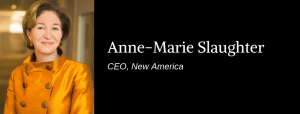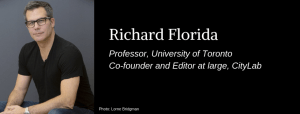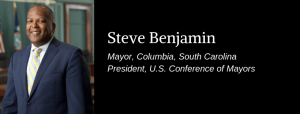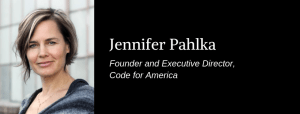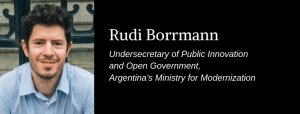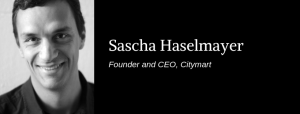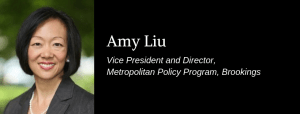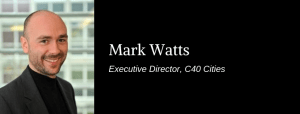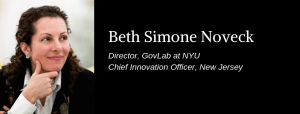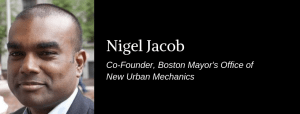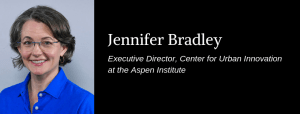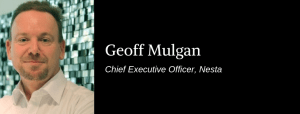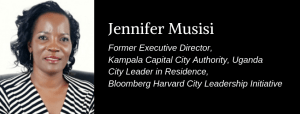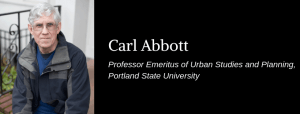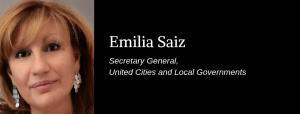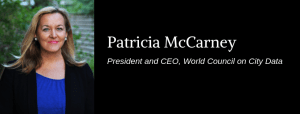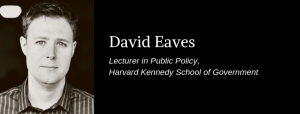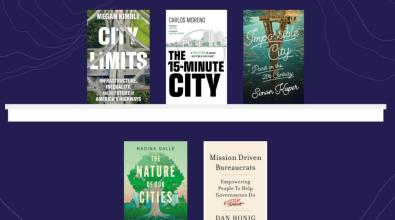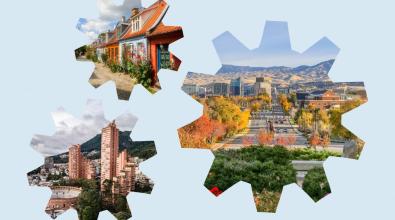The future of city innovation

This is a critical time for city leaders across the United States and around the world. Cities are increasingly understood as the places where humanity’s greatest challenges, from climate change to migration to inequality, impact the most people. They’re also where ambitious leaders are stepping up to think creatively, not only about the catalytic role local government can play in solving these problems — but how, in a time of rapid technological, social, and economic change, they can keep their communities ahead.
This week, as we publish the 100th edition of our weekly newsletter, Spark, Bloomberg Cities spoke with some of the world’s leading urban thinkers about where it’s all headed. We asked mayors, innovators, researchers, futurists, and even the Academy Award-winning production designer behind the capital city of Black Panther’s Wakanda, the same question:
What’s one thing you hope will happen in the world of public-sector innovation over the next 10 years?
Scroll down or click below to read what they had to say.
Mayors will solve problems in new ways
I hope that mayors across the country will fully embrace what Tara McGuinness and I call “the new practice of public problem solving.”
They can do this by bringing their citizens into the center of the problem-solving process, trying out many different solutions and experimenting to get them right, measuring progress against people-centric goals with continuous data flows, and piloting small while designing for scale.
That practice is the opposite of traditional bureaucratic decision-making, in which centralized solutions are handed down from the top and frozen in place through laws and regulations. It is already underway in many places across the country, in both the public and nonprofit sectors; may it spread!
Follow Anne-Marie Slaughter on Twitter @SlaughterAM.
Cities will become platforms for innovation and creative destruction
I think the next decade will see the greatest surge in local public-sector innovation in modern memory. Several trends are coming together in a powerful way to shape this inflection.
For one, as our national politics and government have become polarized, dysfunctional, and ineffective, local government has become more effectively non-partisan, pragmatic, and effective.
Two, our largest cities with the largest public sectors continue to revive and grow, becoming veritable petri dishes for innovation.
Three, as more and more problems and functions are downloaded on local governments, new innovations are being forged and new public-private partnerships are emerging to solve these problems.
Last, and most importantly, we are seeing the rise of a whole new business sector I call “urban tech,” which has become the largest sector of venture capital-backed high-tech startups of all. As our cities become platforms for innovation and creative destruction, we can expect public-sector innovation to soar.
Follow Richard Florida on Twitter @Richard_Florida.
A whole city is a more equitable city
One thing I hope happens in the world of municipal innovation is the idea of city districts and district representatives becomes obsolete.
What we have in cities currently separates people into groups based on income, race, religion, age, and class. That is a vestige of antiquated policies and legislation. These policies determine and limit who gets healthcare, how much you pay for car insurance, what type of education our youth receive, access and opportunities in employment and entrepreneurship, access to public transportation, and so much more. It gives residents little say in the policies that affect them on a daily basis.
I’d like to imagine one city that services its residents equally and equitably. It requires restructuring and reimagining our current cityscapes. This is not to say we need futuristic buildings and flying cars. But this is to say that we could start to imagine the spaces we live in as one, instead of broken pieces that determine who we are and what data might say we are worth based on our ZIP code.
As federal and state funding decreases and cities have to find ways to do more with less, they need to rely on and give power to their residents. That requires trust in people. People are the future of municipal innovation. We’ve lost touch with people.
Breaking the idea of the district/ward/area may be the best way that funding goes to everyone instead of one area getting more funding, or gentrification changing and pushing people out of neighborhoods. It’s something that would demand more involvement from residents, but it would give them a louder voice. It would eventually change how cities look, creating more green spaces, more communal areas, better education, and more involvement in the lives of our youth.
Follow Hannah Beachler on Twitter @chinchilla1970.
Smart public-private partnerships will bloom
Vibrant, modern infrastructure is the defining characteristic of a developed nation, and America has fallen woefully behind her peers by failing to invest in a thoughtful, strategic, and robust plan that will allow us to remain competitive in a global economy.
Our problem is substantial, to say the least. The American Society of Civil Engineers predicts that failing to close the infrastructure investment gap would cause nearly $4 trillion in lost GDP, $7 trillion in lost business sales, and 2.5 million lost jobs by 2025.
In addition to tax exempt bonds, municipal innovators must also find ways to attract additional capital into infrastructure funding through smart public-private partnerships, or P3s.
Effectively deploying P3s in a replicable way will require cities to streamline procurement and approval processes and allow investors, pension funds, and dedicated infrastructure funds to credibly address America’s infrastructure deficit.
Smart P3s that leverage technological innovation, data, our collective wisdom, and sound public policy will allow taxpayers to see major quality-of-life improvements by combining the power of the government with the expertise of private-sector partners, aiming to meet our fiduciary and moral obligations to our citizens and also ensure high-quality work with less risk.
The economic benefits of addressing this challenge would also be significant.
Research from the Council of Economic Advisers predicts that $100 billion in new public infrastructure would raise GDP each year by $12.9 billion, with every billion dollars invested creating 15,000 construction jobs.
Cities are America’s natural incubators of innovation, and we must think more creatively and work together to develop replicable and scalable P3 models to address our massive infrastructure funding deficit.
Follow Steve Benjamin on Twitter @SteveBenjaminSC.
We’ll rely more on creativity than technology
I hope that government will stop thinking of digital as something you buy, but rather something you do.
That doesn’t mean we won’t be buying software. But it does mean that we think of digital as a way we provide services, deeply integrated with operations, customer service, and analysis, ever evolving to meet the needs of the public.
While we will always work with partners to develop and buy technology, over time, local government must develop much more confidence and competence in working with lightweight, simple technology to get the outcomes our constituents need and deserve.
Case in point: Around the country, millions of people still have felonies on their criminal records despite laws reclassifying those felonies to misdemeanors. Why? Because jurisdictions created long, burdensome legal processes that few petitioners could get through.
The technology skills needed to skip that entire process are relatively accessible. But, until recently, no government took advantage of it. That’s probably because people in government tend to assume that access to technology means doing a procurement — itself a long, burdensome process.
But when the right people got in the room and showed what was possible, it changed district attorneys’ understanding of what is possible. And now dozens of jurisdictions have ditched this unnecessary paper-based process and, more importantly, are starting to think differently about other preconceived roadblocks. When technology is no longer a barrier, there’s so much more we can do.
Follow Jennifer Pahlka on Twitter @pahlkadot.
Growing local capacity to innovate
I currently live in Buenos Aires, the capital of Argentina, but I was born and raised in a small village in the north of Patagonia where the town hall is based in an old train station. There are more than 2,000 cities in Argentina, and as is the case in many countries, each municipal administration faces a very different context and reality. Some of them are already using blockchain to safeguard official documents, while others don’t yet have internet access or computers.
Whether large or small, I believe that municipal governments have the best opportunity to transform the way the public sector provides services and engages with citizens. Among the different levels of governments, local administrations are the closest to citizens and are deeply involved in the daily routine of communities. I have met hundreds of mayors who know by heart the name of the people living in the town, and can remember exactly which tree has to be pruned or which street needs to be repaired.
That’s why I believe strongly in capacity building at the local level, and why I hope that in 10 years, constant capacity development programs for the public sector will be the rule and not the exception. What’s needed are training programs offered in a wide variety of formats that can help civil servants learn new methodologies and adopt a digital mindset, but most importantly, foster those skills that make us unique: creativity, teamwork, and empathy. These skills are the cornerstone to designing citizen-centred services and crafting public policies that truly represent the voice and ideas of the citizens.
Follow Rudi Borrmann on Twitter @DonRudi.
Different levels of government will learn to work together
Ten years from now, I hope municipal innovations will be delivered through an integrated system that cuts across different levels of government, laborious administrative barriers, and the present-day “silo mentality” that is the biggest hindrance to the scaling up of innovative solutions.
As 70 percent of all urban infrastructure in 2050 is yet to be built, it is absolutely urgent that we develop an integrated system to ensure our cities, buildings, and homes are planned, designed, and built on sustainable principles. According to a recent International Resource Panel report, it is possible that integrated approaches will result in 20-fold improvements in resource and energy efficiency.
Municipal governance will also be better aligned and integrated with national and sub-national governments 10 years from now. No longer will key policies become homeless because no single level of government wants to take ownership of it or because ministries are busy fighting over it. And municipal governments will be able to take part in nation-to-nation conversations, their access to funding will be more direct, with greater access to the national budget and national-level funders.
All this is helping to ensure that we are better prepared at the municipal level to face the intensifying challenges of climate change and, by ensuring alignment across sectors, also provide the right kind of incentives to encourage greater social integration.
An integrated system will help create the right kind of jobs that will be within reach of the most vulnerable communities. I see greater participation of women and youth in the decision-making process.
Finally, 10 years from now, I hope a more integrated system between all levels of government will help narrow the gap between the citizen and the city; motivate all of humanity to get behind the Sustainable Development Goals, and, in the process, ensure greater human rights so that no one and no place will be left behind.
Follow Maimunah Mohd Sharif on Twitter @MaimunahSharif.
Cities will see procurement as an innovation tool
Can you imagine a world in which “municipal innovation” and “public procurement” will be uttered in the same breath? I can! Tackling procurement is the logical next step for cities to scale what they have achieved in adopting data, evidence, and design thinking to improve their services.
Innovation in procurement matters. Not only is it a formal city process that regulates how we spend, but our evidence also shows that opening procurement from narrow specifications (often repeating recipes from the past) to allowing new ideas, will deliver better outcomes and a much more diverse vendor base. Small businesses, startups, and disadvantaged businesses all shine when given the chance to present better ways of doing things.
This year, for the first time, we measured the state of procurement innovation and openness to small business. Fifty-five major U.S. cities are on track to publish 750 innovative procurements this year — each constituting a formal opportunity for change. A deeper dive into the data shows that cities like Long Beach, Calif., and Pittsburgh lead with a concerted effort to create opportunities for innovation and startups.
Pittsburgh, for example, offers the easiest user experience for startups to explore contract opportunities. Recent opportunities included a request for proposals (RFP) for artists to design pavement markings to honor Pittsburgh’s LGBT+ population; an RFP for software to power PGH Lab, the city’s urban laboratory; and a request for information to find new ways to carry out disparity studies.
In 10 years, we hope to see a lot more cities performing like Pittsburgh and Long Beach. In that future, U.S. cities alone would open up $500 billion in annual spending (2.5 percent of U.S. GDP) to let small business and startups shine with their new ideas that work.
Follow Sascha Haselmayer on Twitter @LLGACities.
Experiential learning will connect youth with the jobs of tomorrow
Every city ought to increase the chances that youth can attain a good-paying, full-time job by adulthood.
To that end, mayors should exponentially expand quality work-based learning programs for teens. Evidence shows that experiential learning, such as internships and apprenticeships, that formally include caring adults who serve as mentors or supervisors, matter. In an age of technological disruption, these programs must also emphasize digital skills training and uniquely human attributes.
Today’s knowledge economy requires cities to have a strong pipeline of talent. Yet automation and new technologies are upending traditional pathways to economic opportunity, particularly for young adults, blacks, and Hispanics, who will comprise a new majority of cities’ future workforce. Recent Brookings research finds that young workers (aged 16–24) are particularly vulnerable to job losses due to automation, thanks to their overrepresentation in fields such as food prep and service. Meanwhile, the fastest-growing demand for workers with computer and technical skills are in low- and middle-skill occupations, such as healthcare support and storage/distribution managers.
To start, mayors might improve and expand on summer jobs programs. First, they can get the basics right — investing in staff and systems to build and maintain relationships with employers and support schools, agencies, and nonprofits in screening and preparing young people. Mayors could add classroom training in key software applications, partner with employers willing to offer experiential learning in creative and technical skills, and prioritize mentoring for women and students of color who are typically underrepresented in tech fields.
Follow Amy Liu on Twitter @amy_liuw.
Freedom from fossil fuels
I hope and believe that within a decade, we will look back with horrified amazement on how internal combustion engine vehicles were allowed to dominate and shape our cities for so long.
Every new study reveals just how toxic gasoline and diesel fumes are to human health, shortening lives and poisoning the hearts and lungs of children. These same emissions are contributing to climate change. The 2018 IPCC report on the Impacts of Global Warming of 1.5 °C was absolutely clear on the threat that climate change poses to the world’s cities.
Fortunately, action is already underway in cities and it looks set to accelerate in the next decade. In April 2019, London Mayor Sadiq Khan will introduce the Ultra-Low Emission Zone, charging drivers of all but the least-polluting vehicles to enter inner London. Similar low-emission zones are already planned or underway in Madrid, Paris, Milan, and Copenhagen.
Twenty-six C40 cities have committed to make large areas of their city center fossil-fuel free by 2030. Several Chinese cities, such as Shenzhen, have successfully replaced their entire fleets with electric buses within just a few years. Those cities which embrace the shift to zero-emission transport most quickly will enjoy cleaner air, healthier communities, lower healthcare costs and greater resilience to the effects of climate change.
The era of the internal combustion engine dominating the world’s great cities is coming to an end. It will not be missed.
Follow Mark Watts on Twitter @MarkWatts40.
Lawmaking will become a two-way conversation with residents
More than 100 legislatures and city councils worldwide are turning to CrowdLaw, or the use of new technologies to tap into diverse sources of resident information, judgment and expertise, to improve the quality of lawmaking. My hope is that, in the next five to ten years, we will see at least double the number of city councils adopting CrowdLaw practices.
Take the example of the capital city of Iceland, which is using an online platform called Better Reykjavik to crowdsource solutions to urban challenges. Residents of Reykjavik submit proposals or vote on proposals submitted by others. Every month, Reykjavik’s Mayor’s Office reviews the best ideas for implementation, which explains why more than half of the city’s population has participated. Since 2011, 20,000 registered users have submitted more than 6,800 proposals; more than 600 projects have been implemented.
Similarly, Mexico City collaborated with Change.org to allow any resident to help craft the city’s new constitution. There was an incentive to not only come up with ideas but get other residents behind them. The mayor committed to analyze any proposal that received 5,000 signatures. If a petition garnered 10,000 signatures, the proposing resident(s) presented to three representatives of the constitutional working group. Petitions with more than 50,000 signatures earned an audience with the mayor. Within six months in 2016, 341 proposals were submitted and 14 petitions were successfully included in the Constitutional draft.
Just as members of the public contribute to writing Wikipedia entries or restaurant reviews on Yelp, CrowdLaw is demonstrating how people can share their professional expertise and lived experience to to foster efficient two-way conversations with the public and enhance the effectiveness and legitimacy of our lawmaking processes.
Follow Beth Noveck on Twitter @bethnoveck.
City leaders will stop equating technology with innovation
My hope is that public-sector leadership expands the ways in which it thinks about innovation.
Currently in local government, more often than not, innovation is equated to technology. This often means that public-sector organizations assume that innovation is about procuring the latest gadget that vendors are pitching. This has the effect of excluding a whole range of more human-centered solutions that use design-process related approaches to building better user experiences for our constituents.
Innovation is NOT equivalent to technology. There is a whole range of possible approaches that we should be tapping.
The traditional public sector drive for efficiency and cost savings should be expanded upon by more human-value notions such as playfulness, delight, and creativity in the development of new and/or better government services for our constituents.
Follow Nigel Jacob on Twitter @nsjacob.
Aiming innovation toward building trust with residents
My hope is that the public sector will innovate towards trust and transparency. This could take several forms.
First, as Michigan Lt. Gov. Garlin Gilchrist says, “The innovation we need is innovation in relationships.” The public sector must create new relationships with communities, particularly communities of color that have every reason not to trust governments. These reformed relationships could be built on digital technologies, but don’t have to be. They could start with a commitment to listening and building solutions with, not for, communities.
Second, the public sector can further trust by steering technology to address challenges identified by marginalized people and neighborhoods. Ask companies to help solve problems such as food deserts, housing insecurity, and unreliable public transit routes in exchange for a smoother path to serving customers who are easiest to reach. It’s happening in some places, but it needs to be the norm.
Finally, the public sector needs to tell a better story about the purpose of innovation in the public realm: not to make money, but to make cities places of opportunity and delight for all residents. (If money follows, fine.) There’s never been a better array of tools for cities to use to “show their work” to residents — human-centered design, gamification, data-visualization — and share the story of the tradeoffs and hard boundaries that make democracy function. The public sector needs to secure residents’ trust in its role as the guardian of the public good. That’s the great goal, and great hope, for the next decade.
Follow Jennifer Bradley on Twitter @JBradley_DC.
Cities will get the best of both machine and human intelligence
I hope that cities will learn to master “intelligence design” so that they can think in the ways that the best human brains do.
That will mean combining observations and data, analysis, and creativity. It will mean mobilizing the full resources of both machine and human intelligence — or, to put it another way, combining AI (artificial intelligence) and CI (collective intelligence).
Intelligence design will, in time, become as important to cities as physical design and spatial planning, and vital for solving the big problems — from clean air to jobs.
There are already glimpses of this future in cities that are pooling data and involving thousands of citizens in shaping policies. But the full benefits will depend on a shift in thinking: looking at intelligence in the round rather than becoming too fixated on individual technologies or data projects.
Follow Geoff Mulgan on Twitter @geoffmulgan.
Leading cities will show others how it’s done
As a city leader, I have always desired for tested and tried solutions that would not eat too much into my limited budget, or take too much time in research and feasibility studies.
Over the next 10 years, we can fill that gap by establishing regional centers of urban excellence. These would be facilities in different regions, including Africa and Asia, where resources on specific areas of need are gathered, deposited, and coordinated — where mayors can, by the click of a button or phone call, request and receive a package of resources to address the needs of their cities.
These centers would be used to incubate and test innovations, and can be used as training centers for city leaders to learn from their peers. The great thing about these centers would be that, if home-grown, they would be developed with specific content taking into account the socio-economic, cultural, and political context of those areas and developing innovations to meet the specific needs.
If these entities are set up and accessible to city leaders worldwide, they would be a tremendous support to cities and enable them to adopt and adapt cost-manageable, tested, and appropriate innovative solutions for the benefit of the urban populations.
Follow Jennifer Musisi on Twitter @JenniferMusisi.
Flexible zoning will unleash creative uses of land
Traditional city zoning laws are extremely hard to change once they are in place. Look around any U.S. city, however, and you see an increasingly temporary cityscape — food carts in pods on underutilized lots and sidewalks, pop-up retail kiosks, tiny houses on trailer beds, and — unfortunately — homeless people in tents and cars.
It is time for cities to stop thinking that zoning needs to lock in land use patterns for the long-term. Instead, they should set aside areas where flexibility is the word. Call it “pod zoning” or “pop-up zoning.”
A derelict shopping mall can be a place for people to set down a shipping container and start building or manufacturing something without worrying about neighbors and building codes. A dozen self-organizing homeless people might pitch their tents on a chunk of unused city land that can’t be used for other purposes like parks.
Science fiction writer Samuel Delany has written about cities’ need for “unlicensed sectors,” where creativity can flourish. That idea should be imported into land-use zoning. The middle class already has their pod and pop-up opportunities in WeWork and Kampgrounds of America. Let’s bring the same options to everyone.
City leaders as protectors of human rights
Our hope is that municipal governments will become true protectors of human rights and equality.
The basic services municipal governments are responsible for — health, education, social services, water and sanitation, transportation, public space — sit at the core of society. Leaders need to recognize the adequate and equitable provision of these services as a human-rights issue, and approach them as such.
This may involve making small yet powerful decisions: confronting national governments on matters of migration and refugees; pushing back against global actors, such as the investment sector, to ensure the right to adequate housing; and taking the lead on protecting emergent rights such as digital or environmental rights, and working with human rights defenders in their promotion. Local governments will also need two things from other levels of government: authority and resources.
Our vision is that municipal governments will help shape a new global concept of citizenship. Our bet is that local governments will only be able to achieve this by joining forces internationally and working with communities, civil society organizations, and national governments.
Follow Emilia Saiz on Twitter @UCLG_Saiz.
A new role for learning spaces
Over the next decade, society will witness an unprecedented scale of change in business.
Disruptive technologies such as artificial intelligence, robotics, autonomous vehicles, drones, blockchain, big data, cloud computing, 5G communications, the Internet of Things, 3D / 4D printing, synthetic biology, new materials, and quantum computing will have unprecedented impact on life, schooling, work, government, and society. Existing jobs will be eliminated, and new higher skilled opportunities will emerge in tomorrow’s industries.
We are in for a massive shock. And our centers of learning — schools, colleges, and universities — can play a massive role in helping society transition across the messy middle to a brighter future.
Across society, we will need to learn new skills, create new businesses, and reinvent ourselves to survive and thrive in a rapidly changing world. Our learning centers are the perfect location to enable that human capital transformation. Many educational facilities are barely used in the evenings and weekends. We can use the empty lecture theaters and classrooms to help people learn new ideas, skills, and personal competencies to help find their next job or create new businesses. Laboratories can be used as maker spaces for people to experiment with new ideas and launch new ventures.
A combination of state and municipal funding, corporate sponsorship, and volunteers from the community could cover the staffing requirements. Using existing kitchen and café space, these centers could also provide a vital place of connection for those who have lost their jobs — allowing them to connect and be inspired rather than waiting at home for the next opportunity to arise.
Follow Rohit Talwar on Twitter @fastfuture.
Cities will close the data gap
Equipping cities with the necessary tools to close the global municipal data gap is vital in driving forward municipal innovation of any kind.
Many cities throughout the world are taking up commanding roles relative to their national governments in terms of GDP. Cities are also pivotal in operationalizing the global 2030 sustainability agenda.
Despite their scale or size, however, cities are still relying on data collection methods, or technology, that is long past its sell-by date.
Since 2014, the World Council on City Data has been growing a network of data-driven cities throughout the world, all reporting 100 globally standardized, comparable, and independently verified key performance indicators through ISO 37120 — the first international standard for cities. It means that Boston, for example, can meaningfully compare itself to Barcelona, Buenos Aires, or Brisbane on measures related to housing, transportation, sanitation, and many other service areas.
Through this work, I have witnessed tremendous and collaborative innovations across cities of all sizes and income levels. In Canada, the city of Cambridge, Ontario, used ISO certification as a way to spot gaps in its data practices and make upgrades. Doing so allowed city leaders to diagnose a critical water infrastructure deficit. By highlighting the globally comparable nature of the ISO data, Cambridge has now set targets to correct water leakage and bring the city in line with peer municipalities across the globe.
Cities are now using this data to drive innovative economic development, aware that traditional financial incentives such as land and tax breaks are no longer the only driving forces to attract talent. Companies want comparable information on transportation, air quality, health services, safety, and even student-teacher ratios in schools — all relevant intelligence when considering where to locate.
For example, Toronto Global — the investment arm for the Toronto region — harnessed this data in its bid for Amazon HQ2. (Toronto was the only Canadian city Amazon shortlisted.) Companies around the world are now leveraging the open bid document when considering moving to Toronto.
In 10 years, I hope to see many more cities throughout the world doing what Cambridge, Toronto, and almost 100 other municipalities worldwide have started to do by reporting ISO 37120 data as well as data on standards related to “smart cities” and urban resilience into the WCCD Global Platform. In an era when global businesses can locate anywhere they choose, and where sustainable infrastructure investment needs are acute and massive, cities need comparable, trusted, and independently verified data to position themselves for a sustainable and investable future.
Follow Patricia McCarney on Twitter @WCCityData.
We will power innovation that can scale
Reflecting back over the past decade of technological innovation in cities there are two significant successes. The first, thanks to Code for America, is that rather than talking about “smart cities,” public servants and politicians were pushed to rethink what citizen-centered design meant in a digital era. The second major accomplishment, thanks in part to the open-data movement, was getting local governments to understand that the data they possessed was a critical asset and that it should be a public one, owned and controlled by them, and not vendors.
For the next decade, my hope is that we can build on the foundations of these two successes to power innovation that can scale. The paradox is that, in order for cities to have the freedom to cheaply create user-focused services and applications, we are going to need common, relatively rigid, underlying infrastructure that is standardized and commoditized across hundreds — or more likely thousands — of cities. Specifically, this means determining what data standards might exist that cities can agree on and start migrating to. This is not a new idea. Open311 has been a partial success in doing this work, but to really enable innovation, at scale, in the 21st century, we are going to need a lot more data, and some processes, standardized across cities. Laying this foundation will be critical to innovation.
Follow David Eaves on Twitter @daeaves.
